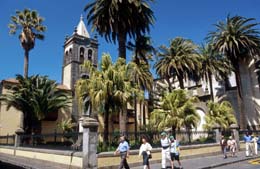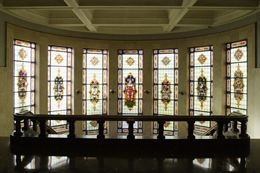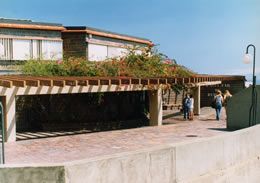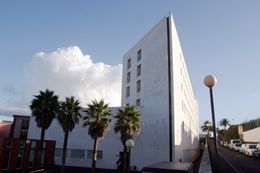Government Pavilion, C/ Padre Herrera s/n
Post Office Box 456
38200, San Cristobal de La Laguna
Santa Cruz de Tenerife - Spain
Switchboard Tel.: (+34) 922 31 90 00
Hours: Mon, 8:00 a.m. to 9:00 p.m.
The University of La Laguna is the oldest institution of higher education in the Canary Islands, with over two hundred years of history. The decree establishing its foundation dates back to March 11, 1792, signed by King Charles IV. Since then, it has gone through several different names and stages, until it acquired its current name in 1913.
Two hundred years after its founding, the University of La Laguna remains a benchmark in the Canary Islands, reaching out to the world through the Atlantic. Currently, this public institution is comprised of more than 25,000 people, including students, faculty, and administrative and service staff.
Its program portfolio includes 46 bachelor's degrees, 38 official master's degrees, 20 doctoral programs, and 15 university-specific degrees. It also has a total of 21,678 enrolled students.
The ULL is undergoing an internal renovation process that will leverage new information technologies and online education, centralized in its Virtual Teaching Unit.
The Canary Islands' strategic tricontinental position compels its universities to take a leading position in the Atlantic region they occupy.

The origins of university activity in the Canary Islands date back to 1701, when a center for higher education for the Augustinian religious was established in the city of La Laguna. Its subsequent historical evolution is marked by a series of regulations and repeals that began in 1744, when a Papal Bull transformed the center into the Ecclesiastical University of Saint Augustine, which never came into being.
In 1792, a Royal Decree issued by Charles IV on March 11 ordered the creation of the first Literary University in the Canary Islands archipelago in the then capital of Tenerife. However, the turbulent political situation that had developed since 1793 prevented its effective establishment. Once the Bourbon dynasty was restored, Ferdinand VII revived the long-standing aspiration of the Canarians to have a higher education institution on the islands and, seeking to settle inter-island rivalries over its location, in 1816 issued a new Royal Decree resolving to "establish in the city of San Cristóbal de La Laguna a university with the same privileges, exemptions, and prerogatives enjoyed by the other universities in these kingdoms, and that said university be named and called the University of San Fernando." To this end, the Jesuit school in La Laguna became the first headquarters of the Literary University of San Fernando, which opened its doors as an academic institution on January 12, 1817.
But soon, the building proved insufficient for the progressive increase in students, so in December 1821 the partial transfer of the University to the Convent of San Agustín began, where the students lived together with the religious community, until finally, in 1837, the entire Convent was used for university activities, following the Mendizábal disentailment law, which led to the forced exclaustration of the religious members of the Order.
Thus, the Jesuit College House was used to house the branch hall, the cloister and public events hall, the library, as well as the Latin studies and the elementary school dependent on the La Laguna City Council. The Patriotic Society and the Royal Economic Society of Friends of the Country also had a meeting room in this building. However, the numerous deficiencies suffered by the University, primarily due to the lack of resources and permanent teaching staff, led to successive orders to reopen and close it, until it was finally abolished in 1845 by a Royal Order that reduced the number of Spanish universities to ten and established the creation of the Canary Islands Institute in La Laguna.
Bibliography: NÚÑEZ MUÑOZ, María F. (editors): History of the University of La Laguna, SPULL (Institutional Publications), volumes I and II. Tenerife, 1998.
In 1906, during a visit to the Institute by King Alfonso XIII, its director, Adolfo Cabrera Pinto, took the opportunity to ask the monarch to reestablish the University of San Fernando. The first results of this petition arrived in 1913, with a royal decree establishing university courses in La Laguna corresponding to the first year of the Faculty of Philosophy and Letters and preparatory to the Faculty of Law. These courses would be taught on the Institute's premises, with the director of the Center, Cabrera Pinto, in charge of their management.
This University Section was expanded in 1917 to include the preparatory course for admission to the Faculties of Medicine and Pharmacy. In 1921, the Law studies were completed, allowing La Laguna to once again be considered a university city. However, it was not until 1927, by Royal Decree of September 21, that the University of La Laguna was created, becoming the 12th Spanish university district. The rector was José Escobedo y González-Alberú, who had been the dean-in-chief of the University Section until then. This royal decree definitively created the Faculties of Law and Chemical Sciences, and the preparatory course for Philosophy and Letters, which was subsequently completed.
The gradual expansion of the faculties led to the undertaking of the task of promoting the construction of a new building to house the University. Thus, in 1929, a competition for preliminary designs was announced for the construction of the University building and a college, on a plot belonging to the La Laguna City Council in a place called "El Cercado del Marqués." Of the proposals submitted, that of architect Ceballos was chosen. In 1935, the works were awarded, but suffered serious delays due to, among other causes, the Civil War and the new political regime that had been established.
In 1942, Classical Languages studies were established, leading to the creation of the Faculty of Philosophy and Literature; five years later, these studies were replaced by the Romance Languages studies. Finally, in 1960, the new University building was fully inaugurated on the current Central Campus. At that time, it housed the Faculties of Law and Science, the General Library, the Rector's Office, and the secretariats.
With the new facilities, the University of La Laguna expanded. The English Philology (1963), Biology (1967), and Mathematics (1969) departments were established, at the same time as the creation of the Faculty of Medicine (1968). The subsequent growth of the institution was marked by the incorporation of new studies, the division of knowledge, and other diverse issues that led to the creation of new centers, to the point where it can now compete with the leading universities in Spain. In 1972, the University School of Business Studies and the Teacher Training School were established, and a year later, the School of Technical Architecture.
The Faculty of Pharmacy was established in 1974, and the Faculty of Economics and Business Administration in 1975. The University School of Nursing was established in 1977, one year before the division of the Faculty of Sciences and the creation of the Faculties of Biology and Mathematics. In the same year, 1978, the University School of Social Work was incorporated, and in 1979, the Faculty of Fine Arts. In 1982, the former Faculty of Philosophy and Letters was separated into the Faculties of Philology, Philosophy, Psychology and Educational Sciences, and Geography and History.
In 1987, the former University School of Nursing was renamed the School of Nursing and Physiotherapy. In 1988, the Faculty of Information Sciences was created, and in 1989, the Faculty of Psychology and Physics. The 1990s were characterized by the emergence of a new type of center, more in line with the reality imposed by the new Spanish university system. Thus, the Higher Centers of Nautical and Marine Studies and of Computer Science (1990), the Center for Agricultural Sciences (1991), and, in 1995, the Center for Education were established. Finally, in 1999, the Higher Center for Political and Social Sciences was established.
On the other hand, it should be noted that the increasing demand for higher education by Canarian society led the University of La Laguna to create the Las Palmas University College, with studies in Medicine (1973) and the first cycles of Law, Philology, Geography and History (1982), which were under the academic tutelage of the Tenerife higher education center until the University of Las Palmas de Gran Canaria was created in 1989.
Bibliography: NÚÑEZ MUÑOZ, María F. (editors): History of the University of La Laguna, SPULL (Institutional Publications), volumes I and II. Tenerife, 1998.





The University of La Laguna, whose headquarters are located in the city on the island of Tenerife that gives it its name, exercises throughout the Canary Islands the duties assigned to it by law. As stated in its Statutes, the University of La Laguna is a public law institution, endowed with legal personality and its own assets, which operates autonomously in accordance with the Constitution and the Laws, and is responsible for providing the public service of higher education. Its activity is based on the principle of academic freedom, which is manifested in the freedoms of teaching, study, and research recognized by law, while also guaranteeing the rights of free expression and dissemination of thought, as well as of artistic, humanistic, scientific, and technical production and creation.
The University of La Laguna is organized democratically, in the manner and form established by the Organic Law of Universities, ensuring the representation and participation of the various sectors that make up the university community in its governance and that of its various centers. Today, the University of La Laguna has 21,678 students, 1,619 professors, and 841 administrative and service staff.
Two hundred years after its founding, the University of La Laguna remains a benchmark in the Canary Islands, reaching out to the world through the Atlantic. Its program includes 47 undergraduate degrees, 38 official master's degrees, 21 doctoral programs, and 11 university-specific degrees. It also has a total of 21,678 students enrolled.
Bibliography: NÚÑEZ MUÑOZ, María F. (editors): History of the University of La Laguna, SPULL (Institutional Publications), volumes I and II. Tenerife, 1998.